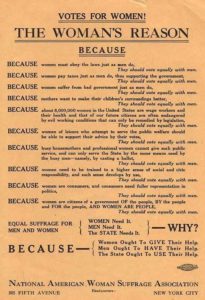
Today in Feminist History is our daily recap of the major milestones and minor advancements that shaped women’s history in the U.S.—from suffrage to Shirley Chisholm and beyond. These posts were written by, and are presented in homage to, our late staff historian and archivist, David Dismore.
December 20, 1912: This fifth day of General Jones and her suffrage army’s hike through New York State from the Bronx to Albany saw sore feet causing a late start, but better weather, as well as renewed commitments by the marchers.
This afternoon’s sendoff in Fishkill was enthusiastic, and included the Village President, the Chief of Police, and a number of local suffragists as well.
Though the day started and ended well, an experiment in recruiting along the route was somewhat less than successful. Colonel Ida Craft, always eager to promote the cause to all, decided it might be a good idea to make up a pro-suffrage flyer specifically addressed to some of the hobos the troops encounter in their travels.

Upon seeing someone who clearly seemed to qualify for this recruitment drive resting at the side of the road, Craft gave him a flyer, only to quickly learn that he was one of the county’s wealthiest landowners, and not at all flattered by the case of mistaken identity.
The next encounter went far better. In another of the pilgrims’ unannounced visits to roadside schoolhouses, 25 children listened attentively to General Jones and nurse Lavinia Dock, the army’s Surgeon-General. One boy seemed quite supportive of women having the vote, but when Dock predicted that some day Jones might be President, this brought a worried look to his face. But at least he supports the most important step toward putting a woman in the White House, even if he’s not quite ready for a Jones Administration just yet. The teacher, Elizabeth Livingston, was undecided on the issue—but now that she has lots of literature to look over during the long winter, that should change.
Moving farther down the road, Colonel Craft was doing her usual duty of stuffing suffrage literature into mailboxes when a farmer noticed and vigorously objected. But her enthusiasm for the cause, and logical arguments in favor of woman suffrage, were sufficient to get him to at least think about supporting the right of women to vote.
Near the day’s objective of Wappingers Falls, it was the army’s medical officer who needed attention. But after a few minutes of rest and some shoe-shaking, Dock’s malady was cured.
As their goal-of-the-day approached, there was still one formidable obstacle to overcome. General Jones’ mother, having read of the exhausting pace—64 miles in just the first four days of the hike—sent a nurse out to intercept the hikers, check on the General’s health and implore the Commander-in-Chief to give her “Farewell Address to the Troops” and come home. But the General had no intention of deserting her army.
“I am carrying a message to Garcia–beg pardon—[Governor-elect] Sulzer,” she declared. “I am going to walk to Albany. You may go right home and tell mother so.” This statement caused the other hikers to make renewed pledges to reach Albany as well.
The pilgrims attended a dance held this evening at the Wappingers Falls Academy of Music, though Captain and Chief Orator Jessie Hardy Stubbs did all the actual dancing for the group. She is now a full-time speaker who delivers her speeches from the baggage car, and no longer one of the three hikers. This way she can spend as much time as possible speaking and answering questions at the army’s many stops, then can quickly catch up with the hikers.
Apparently the fame of the pilgrims is now sufficient that at tomorrow’s luncheon in Poughkeepsie, an admission fee will be charged to the sold-out event, with the proceeds going to help “The Cause.”
This first-ever suffrage hike is meant to generate attention and support for the suffrage movement in general, and specifically for putting a suffrage referendum on the New York State ballot. It is hoped that the hikers will reach Albany before the end of the year, and meet with Governor-elect Sulzer to obtain his support for a “Votes for Women” referendum drive.
This has already become a spectacularly successful suffrage event. Three hikers walking around rural New York State with a contingent of “War Correspondents” sending back stories to their papers are generating far more publicity this week than a National American Woman Suffrage Association meeting in Chicago.
The last time such a small group of U.S. suffragists generated widespread publicity was on February 16, 1908, when two dozen members of the Progressive Woman Suffrage Union defied custom – and the police – by staging the first “suffrage parade” down Broadway in Manhattan. Since then, such parades and pageants have become annual events, and a respected city tradition, with between 15,000 and 20,000 marchers in New York’s suffrage parade earlier this year. This newest innovation seems to be in as unique a category of effectiveness as that original 1908 march, so it’s a good bet that the end of the hike in Albany will not be the last of General Jones’ pilgrimages.





